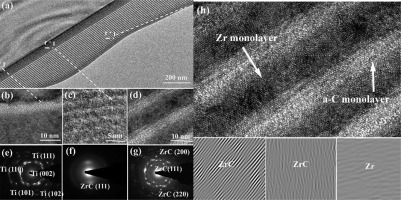Surface & Coatings Technology ( IF 5.3 ) Pub Date : 2020-01-21 , DOI: 10.1016/j.surfcoat.2020.125391 Dongguang Liu , Tingting Yang , Haoran Ma , Y. Liang

|
One type of carbon-based bioceramic composite film, zirconium (Zr) incorporated amorphous carbon (Zr/a-C) gradient multilayer films (GMFs), is deposited on titanium (Ti) alloys by magnetron sputtering to attain superior biocompatibility and mechanical and bio-tribological properties. The morphologies and structure of Zr/a-C GMFs were analyzed using X-ray diffraction (XRD), scanning electron microscopy (SEM), X-ray photoelectron spectroscopy (XPS), and transmission electron microscopy (TEM). XRD and SEM and TEM analysis confirmed the gradient multilayer nature of the film, and the presence of nanostructured fcc-ZrC at the Zr/C layer interface for Zr content of 6.3 at.%. XPS analyses confirmed elevated sp2 bond content as a result of incorporating the Zr interlayer in the a-C matrix. The tribological properties of Zr/a-C GMFs were defined using a tribometer with a fetal bovine serum (FBS) solution, in which all Zr/a-C GMFs exhibited improved wear resistance, compared to the pure a-C film and Ti alloy. Additionally, Zr/a-C GMFs exhibited the lowest friction coefficient (COF) at 0.114, and a wear rate of 1.47–1.56 × 10−6 mm3/Nm, compared to pure a-C films and Ti alloy. Phase composition and the superior mechanical properties of GMFs were determined as crucial factors contributing to the enhanced wear resistance and low COF in Zr/a-C GMFs. Furthermore, osteoblast cell viability and proliferation on GMF films were tested in cultures, and results indicated that Zr/a-C GMFs have better biocompatibility, compared to Ti alloy. Cell adhesion experiments also demonstrated the excellent biocompatibility and functional reliability of composite biofilms for potential application in bone implants.
中文翻译:

非晶碳生物陶瓷复合膜中掺锆的钛表面的微观结构,生物摩擦学性能和生物相容性
一种类型的碳基生物陶瓷复合膜,即掺有锆(Zr)的无定形碳(Zr / aC)梯度多层膜(GMFs),通过磁控溅射沉积在钛(Ti)合金上,以获得优异的生物相容性以及机械和生物摩擦学性能属性。Zr / aC GMF的形态和结构使用X射线衍射(XRD),扫描电子显微镜(SEM),X射线光电子能谱(XPS)和透射电子显微镜(TEM)进行了分析。XRD和SEM以及TEM分析证实了膜的梯度多层性质,并且对于Zr含量为6.3at。%,在Zr / C层界面处存在纳米结构的fcc-ZrC。XPS分析确认sp 2升高通过在aC矩阵中掺入Zr中间层而获得键含量。Zr / aC GMF的摩擦学性能是用带有胎牛血清(FBS)溶液的摩擦计定义的,与纯aC膜和Ti合金相比,所有Zr / aC GMF都表现出更高的耐磨性。此外,Zr / aC GMF在0.114处表现出最低的摩擦系数(COF),且磨损率为1.47–1.56 × 10 -6 mm 3/ Nm,与纯aC膜和Ti合金相比。确定了GMF的相组成和优异的机械性能是导致Zr / aC GMF增强耐磨性和降低COF的关键因素。此外,在培养物中测试了成骨细胞的存活能力和在GMF膜上的增殖,结果表明,与Ti合金相比,Zr / aC GMF具有更好的生物相容性。细胞粘附实验还证明了复合生物膜具有出色的生物相容性和功能可靠性,可潜在地应用于骨植入物。









































 京公网安备 11010802027423号
京公网安备 11010802027423号